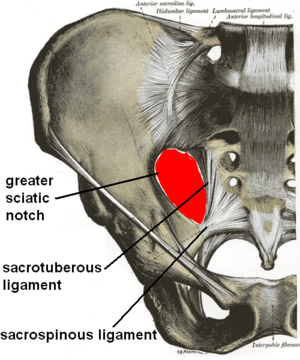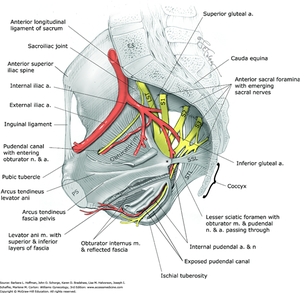Sacrospinous Ligament: Difference between revisions
(Created page with "== Description == center|thumb The Sacrospinous ligament (small/anterior sacrosciatic ligament of the sacroiliac joint) is a pelvic ligame...") |
No edit summary |
||
| Line 3: | Line 3: | ||
The Sacrospinous ligament (small/anterior sacrosciatic ligament of the sacroiliac joint) is a pelvic ligament. It is a thin triangular band and about 3.8-4.6cm in length. | The Sacrospinous ligament (small/anterior sacrosciatic ligament of the sacroiliac joint) is a pelvic ligament. It is a thin triangular band and about 3.8-4.6cm in length. | ||
The sacrospinous ligament's fibers are intermingled with the [[Sacrotuberous Ligament|sacrotuberous ligament]]. <ref>Hammer N, Steinke H, Slowik V, Josten C, Bohme J, Spanel-Borowski. The sacrotubetous and the sacrospinous ligament--a virtual reconstruction [online]. 2009 October. Available from:https://pubmed.ncbi.nlm.nih.gov/19457648/ (last accessed 18/11/2020)</ref>Posteriorly, the sacrotuberous ligament passes behind the sacrospinous ligament. Anteriorly, The sacrospinous ligament covers the coccygeus muscle. It is attached from the spine of the ischium and the outer edge of the sacrum and coccyx.<ref name=":0">https://www.imaios.com/en/e-Anatomy/Anatomical-Parts/Sacrospinous-ligament</ref> | The sacrospinous ligament's fibers are intermingled with the [[Sacrotuberous Ligament|sacrotuberous ligament]]. <ref>Hammer N, Steinke H, Slowik V, Josten C, Bohme J, Spanel-Borowski. The sacrotubetous and the sacrospinous ligament--a virtual reconstruction [online]. 2009 October. Available from:https://pubmed.ncbi.nlm.nih.gov/19457648/ (last accessed 18/11/2020)</ref>Posteriorly, the sacrotuberous ligament passes behind the sacrospinous ligament. Anteriorly, The sacrospinous ligament covers the [[coccygeus]] muscle. It is attached from the spine of the ischium and the outer edge of the sacrum and coccyx.<ref name=":0">https://www.imaios.com/en/e-Anatomy/Anatomical-Parts/Sacrospinous-ligament</ref> | ||
== Attachments == | == Attachments == | ||
| Line 12: | Line 12: | ||
== Function == | == Function == | ||
The sacrospinous and sacrotuberous ligaments assist in pelvic stability. The ligament works with the sacrotuberous ligament to prevent rotation of the illum past the sacrum thus preventing excessive twisting of the pelvis, low back pain, and SIJ strain. | The sacrospinous and sacrotuberous ligaments assist in pelvic stability. The ligament works with the sacrotuberous ligament to prevent rotation of the illum past the sacrum thus preventing excessive twisting of the pelvis, low back pain, and [[Sacroiliac joint|SIJ strain.]] | ||
<ref>Til L.Working with Sacrotuberous Ligaments.Associated Bodywork & Massage Professionals.2012 September. ABMP Publishing</ref>{{#ev:youtube|UG2e1QlMTqk}}<ref>Guenevere Rae. Sacrospinous and sacrotuberous Ligaments. Available from: https://www.youtube.com/watch?v=UG2e1QlMTqk&feature=youtu.be [last accessed 18/11/2020]</ref> | <ref>Til L.Working with Sacrotuberous Ligaments.Associated Bodywork & Massage Professionals.2012 September. ABMP Publishing</ref>{{#ev:youtube|UG2e1QlMTqk}}<ref>Guenevere Rae. Sacrospinous and sacrotuberous Ligaments. Available from: https://www.youtube.com/watch?v=UG2e1QlMTqk&feature=youtu.be [last accessed 18/11/2020]</ref> | ||
| Line 24: | Line 24: | ||
[[Category:Ligaments]] | [[Category:Ligaments]] | ||
<references /> | <references /> | ||
[[Category:Pelvis - Anatomy]] | |||
[[Category:Pelvis]] | |||
Revision as of 13:50, 18 November 2020
Description[edit | edit source]
The Sacrospinous ligament (small/anterior sacrosciatic ligament of the sacroiliac joint) is a pelvic ligament. It is a thin triangular band and about 3.8-4.6cm in length.
The sacrospinous ligament's fibers are intermingled with the sacrotuberous ligament. [1]Posteriorly, the sacrotuberous ligament passes behind the sacrospinous ligament. Anteriorly, The sacrospinous ligament covers the coccygeus muscle. It is attached from the spine of the ischium and the outer edge of the sacrum and coccyx.[2]
Attachments[edit | edit source]
The sacrospinous ligament acts as a border for the greater and lesser sciatic foramen. The greater sciatic foramen lies above the ligament giving way for superior gluteal nerves and vessels to emerge from the pelvis while acting as a passage for the inferior gluteal vessels and nerve, sciatic and posterior femoral cutaneous nerves to pass through and exit the pelvis.
The lesser sciatic foramen is below the ligament, transmitting the tendon of the obturator internus, its nerve, and the internal pudendal vessels and nerve[2]
Function[edit | edit source]
The sacrospinous and sacrotuberous ligaments assist in pelvic stability. The ligament works with the sacrotuberous ligament to prevent rotation of the illum past the sacrum thus preventing excessive twisting of the pelvis, low back pain, and SIJ strain.
Clinical relevance[edit | edit source]
Sacrospinous fixation/ Illeococcygeus suspension is a procedure where the apex of the vagina is sutured to the sacrospinous ligament. this procedure is recommended to patients with uterine and vaginal prolapse as it may offer sturdier support than the weakened pelvic prolapse.[5]
Pudendal nerve entrapment between the sacrotuberous and sacrospinous ligament is one of the common causes of pudendal entrapment neurological manifestations that can cause pelvic pain. With a tight ligament, the pain is referred down to the central aspect back of the thigh.[7]
- ↑ Hammer N, Steinke H, Slowik V, Josten C, Bohme J, Spanel-Borowski. The sacrotubetous and the sacrospinous ligament--a virtual reconstruction [online]. 2009 October. Available from:https://pubmed.ncbi.nlm.nih.gov/19457648/ (last accessed 18/11/2020)
- ↑ 2.0 2.1 https://www.imaios.com/en/e-Anatomy/Anatomical-Parts/Sacrospinous-ligament
- ↑ Til L.Working with Sacrotuberous Ligaments.Associated Bodywork & Massage Professionals.2012 September. ABMP Publishing
- ↑ Guenevere Rae. Sacrospinous and sacrotuberous Ligaments. Available from: https://www.youtube.com/watch?v=UG2e1QlMTqk&feature=youtu.be [last accessed 18/11/2020]
- ↑ Sandip P, Rodney A, Peter K, Shlomo R. 29 December 2004. Female Urology, Urogynecology, and Voiding Dysfunction.Infrorma Health Care. ISBN 0-8247-5426-3.
- ↑ Green Journal. Sacrospinous Ligament Fixation- An Instructional Video filmed using a telescope. Available from;https://www.youtube.com/watch?v=qEVRtaIfyqU&feature=youtu.be [last accessed 18/11/2020]
- ↑ Kaur J, Singh P. Pudendal Nerve Entrapment Syndrome. InStatPearls [Internet] 2019 Jun 21. StatPearls Publishing.








